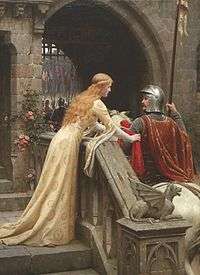< Brief History of Europe 

Romanticized vision of chivalry in the Middle Ages (God Speed by Edmund Leighton, 1900)
The Middle Ages (or medieval period) lasted roughly from the 5th to the 15th century. It can be considered as from the period from the end of classical antiquity with the fall of Rome in 476, to the fall of Constantinople in 1453. It followed Classical antiquity, which was circa 8th –7th century BC to the fall of Rome. Medium aevum (Latin for middle age) gave rise to the term “medieval”.
It can be divided into:
- Early Middle Ages, which was circa AD 500–1000, and sometimes referred to as the Dark Ages, although this is controversial. It was a time of new empire building, most importantly Francia (the Frankish empire). The rise of Islam created a rivalry with the Byzantine Empire, and Iberia would soon be conquered by them.
- High Middle Ages, which was circa AD 1000–1300, or 1000–1250. After the Norman conquest of England, the English Plantagenet dynasty would rival the French kings for France. The Holy Roman Empire would get established as a powerful Germanic empire. There was religious turmoil with the crusades, and with the Great Schism the Catholic and Orthodox churches would separate.
- Late Middle Ages was circa AD 1300–1500 or 1250–1500. The Crisis of the Late Middle Ages was a series of famines, plagues, peasant revolts, and wars, that devastated European populations. It was also the period of the rise of the Ottoman Empire, who would overthrow the Byzantine Empire and come to dominate the Balkans.
See also Wikipedia:Middle Ages.
This article is issued from
Wikibooks.
The text is licensed under Creative
Commons - Attribution - Sharealike.
Additional terms may apply for the media files.